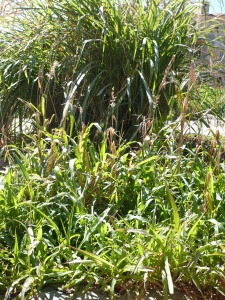I took a tour of the Ethnobotanical Garden, to learn about all the local plants and their traditional uses. Here’s some of my notes.
There are 16 indigenous ethnic groups in Oaxaca. The region has a great diversity of flowering plants. All the plants in the garden originate from the state of Oaxaca. Corn, beans and squash were domesticated here. The first domesticated plant was squash. Some seeds traced to 8000BC were found near Mitla, archeobotanists can tell by morphological changes in the seed that it is a domesticated plant. It was at this same time that plants were first domesticated in the Euphrates. In the years 8000BC – 1500BC gradually more plants were domesticated. In 1500BC the first villages appeared. This reads like a primary school research project essay.
Rosita de Cacao – little rose flower. It’s not cacao. The flower is used in a traditional drink called tehate, which is made from maize, cacao, the toasted ground seeds of mamey fruit, and the rosita flower. Dried powdered tehate stores well and is easily portable.
Five species of peppers were domesticated, three in South America and two in Mexico. Chilli peppers are high in vitamin C, they clear the sinuses and release endorphins. To the Aztecs, peppers are magic, and ward off evil and disease. They are also a preservative, and for this reason have been adopted worldwide. An active ingredient capseisin blocks pain signals to the brain, and is used in pharmaceuticals. It is also analgesic, it encourages blood to flow to the surface.
Tomatoes were domesticated in Mexico, but were considered poisonous in the rest of the world.
Maiz creollo is the locally cultivated corn. The first domesticated corn was found to be in 4250BC. Teosinte is the grass that corn was developed from. It is a multi-stemmed plant, with many seed pods, and doesn’t look like a promising food plant. Grasses are mutable, and it was a mutation that led to domestication. In 7000BC the domestication process began, and by 4250BC the domesticated plant was dependent on humans.
The earliest evidence of plant domestication was found in the mountains of Oaxaca. Once domesticated, these plants spread quickly to other regions.
To the local indigenous people, trees are sacred, representing the gods and the universe.
A tree known as chapote or kapok is especially sacred, and represents the connection between upper and lower worlds. The Mixtec creation story tells of people originating from trees. The tree was stabbed with an arrow by a god, who split the tree open and people sprang out. A carved bone found in a tomb at Monte Alban shows a picture of a tree birth.
This tree is not used for timber, as it is sacred. The seed pod contains a fibre, which is used as a stuffing material. It was used for lifejackets until a synthetic alternative was developed. The fibre is still used in Africa as insulation.
Some drylands trees are deciduous so as not to lose moisture in the dry season. They flower in the dry season, then the seed falls and is ready to germinate in the rainy season.
Agave plants (called maguey) are used as fibre, and become important throughout the world in the 1700s as it was used to make shipping ropes. The fibre was also used for bags, hammocks, sandals and fishnets.
Fermented maguey juice is called pulque, and is similar to beer. It was used in rituals by priests and nobles to honour the gods, and also as a tonic for elderly and sick people. Pulque disappeared from use for a long time, and is now making a comeback.
Opuntia (prickly pear) fruits and pads are eaten, and the cochineal bug that feeds on the plant was used as a red dye. In 1774 hundreds of tonnes of cochineal were exported to Spain. The building of Oaxaca was funded by the trade in cochineal. In 1870 a synthetic dye was created, and by 1914 cochineal was no longer used. Changing the pH of a cochineal dye manipulates the colour, so by adding lemon juice or soda, a range of colours from yellow to purple can be created.





